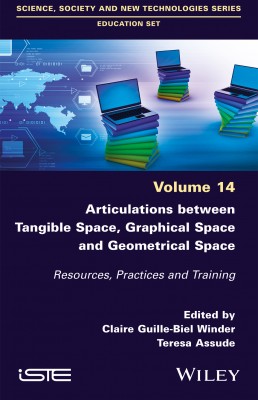
This book aims to present some of the latest research in the didactics of space and geometry, deepen some theoretical questions and open up new reflections for discourse. Its focus is as much on the approach of geometry itself and its link with the structuring of space as it is on the practices within the classroom, the dissemination of resources, the use of different artefacts and the training of teachers in this field.
We study how spatial knowledge, graphical knowledge and geometric knowledge are taken into account and articulated in the teaching of space and geometry in compulsory schools, teaching resources (programs and textbooks) and current teacher training. We question how the semiotic dimension (language, gestures and signs) of geometric activity can be taken into account, and we identify the role of artefacts (digital or tangible) in the teaching and learning of geometry. This book brings together some fifteen contributions from French-speaking researchers from different countries (France, Switzerland and Canada).
Part 1. Articulations between Tangible Space, Graphical Space and Geometric Space.
1. The Geometry of Tracing, a Possible Link Between Geometric Drawing and Euclid’s Geometry? Anne-Cécile Mathé and Marie-Jeanne Perrin-Glorian.
2. How to Operate the Didactic Variables of Figure Restoration Problems? Karine Vièque.
3. Early Geometric Learning in Kindergarten: Some Results from Collaborative Research, Valentina Celi.
4. Using Coding to Introduce Geometric Properties in Primary School, Sylvia Coutat.
5. Freehand Drawing for Geometric Learning in Primary School, Céline Vendeira-Maréchal.
Part 2. Resources and Artifacts for Teaching.
6. Use of a Dynamic Geometry Environment to Work on the Relationships Between Three Spaces (Tangible, Graphical and Geometrical), Teresa Assude.
7. Robotics and Spatial Knowledge, Emilie Marie.
8. Contribution of a Human Interaction Simulator to Teach Geometry to Dyspraxic Pupils, Fabien Emprin and Edith Petifour.
9. Research and Production of a Resource for Geometric Learning in First and Second Grade, Jacques Douaire, Fabien Emprin and Hen-Claude Argaud.
10. Tool for Analyzing the Teaching of Geometry in Textbooks, Claire Guille-Biel Winder and Edith Petitfour.
Part 3. Teaching Practices and Training Issues.
11. Study on Teacher Appropriation of a Geometry Education Resource, Christine Mangiante-Orsola.
12. Geometric Reasoning in Grades 4 to 6, the Teacher’s Role: Methodological Overview and Results, Sylvie Blanquart.
13. When the Teacher Uses Common Language Instead of Geometry Lexicon, Karine Millon-Fauré, Catherine Mendonça Dias, Céline Beaugrand and Christophe Hache.
14. The Development of Spatial Knowledge at School and in Teacher Training: A Case Study on 1, 2, 3… imagine! Patricia Marchand and Caroline Bisson.
15. What Use of Analysis a priori by Pre-Service Teachers in Space Structuring Activities? Ismaïl Mili.
Part 4. Conclusion and Implications.
16. Questions about the Graphic Space: What Objects? Which Operations? Teresa Assude.
17. Towards New Questions in Geometry Didactics, Claire Guille-Biel Winder and Catherine Houdement.
Claire Guille-Biel Winder is a lecturer in mathematics education at Aix-Marseille Université (ADEF team), France. Her research focuses on the teaching of geometry in primary school, as well as on the practices and training of elementary school teachers.
Teresa Assude is a full professor in mathematics education at Aix-Marseille Université (ADEF team), France. Her research focuses on the study of preventive aid systems, the use of digital technologies and the teaching of mathematics to disabled students.